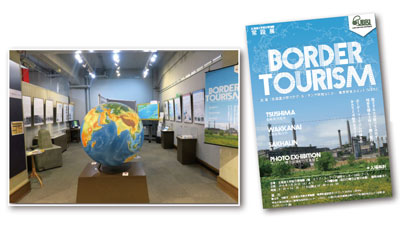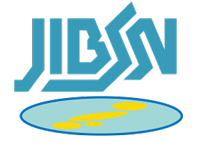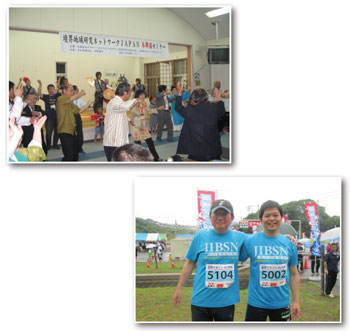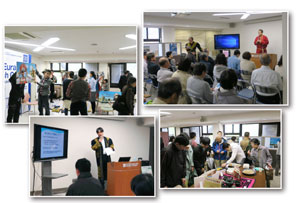About the SRC
Outline
Social Collaboration

M
useum Exhibits
The Unit for Border Research (UBRJ) actively returns profits from the research results in regard to border studies to society. Some of these include the exhibits at the special booth setup in the Hokkaido University Museum, the production of related DVDs, and the hosting of public seminars. Ever since 2009, the great numbers of exhibits that have been on display at the museum over a course of ten seasons have been viewed by many visitors and have also been covered in depth by the media a number of times. Of these, the rotating globe that became a symbol of the exhibits is a precious piece in which the topography has been reproduced with the depths of the oceans recreated to scale and has left visitors with a strong impression together with the replica of the stone monument marking the border between Japan and Russia that is placed at a latitude of 50 degrees north in Sakhalin. In light of how regional studies focus on the actual site and value the information stemming from the site as being the most important, such museum exhibit that enables visitors to experience the actual site is one of the best ways to communicate the results of research to the community. While the special booth has communicated information on the various national boundary/border regions of the Eurasian continent and Japan, the exhibits currently on display are formed around the keyword of “Border Tourism” aiming for regional development.

C
ollaboration with Civic Groups and
Local Governments such as Sapporo
The “Let’s Think Together Lectures,” which started due to the Great East Japan Earthquake and the Fukushima nuclear disaster, are being hosted at a pace of almost once a month. The fact that a nuclear disaster occurred in 1986 in Chernobyl of the former USSR, referred to as the core of the Slavic-Eurasian region, is also a background to these lectures being held. It is necessary to think about the earthquake and the problems of the nuclear accident from the perspectives of not only experts of natural sciences such as nuclear power and disaster prevention, but also humanities and social sciences because the suffering from damage and recovery therefrom is a problem that involved the region and its people. The purpose of the lectures is for citizens and the university to come together and think about the future world and ways of obtaining new knowledge, and lectures and study groups are being jointly held with civic groups and local governments from within Sapporo, Rankoshi, Kyowa, and Iwanai, etc.

In addition, related to the Unit for Border Research (UBRJ), through the activities of the Japan International Border Studies Network (JIBSN: established in 2011), national border governments throughout Japan (Wakkanai, Ogasawara, Tsushima, Taketomi, Yonaguni, etc.), regional think tanks, and NPOs are being connected and activities for planning policies and developing human resources are being expanded. Please refer to the JIBSN website for further details. WebsiteURL
WebsiteURL
http://src-h.slav.hokudai.ac.jp/jibsn/

P
ublic Lectures
Since 1986, the center has been hosting lectures for the general public. Every year, there are applications for participation from roughly 50-100 people and the contents of the lectures are published in various forms.
Past Lectures
2016 “The realities of gender in the Slavic-Eurasian societies”
2015 “Eurasia in Turmoil: Flaring Conflicts, Turbulent Politics and Economy”
2014 “Eurasia in the Memory” 2013 “The Modern State and Religions of Eurasia”
2012 “Who will Protect the Nature and Environment of Eurasia?”
2011 “People of Vigor in the Slavic-Eurasian Region”
2010 “Attempting to Compare Major Regional Powers: What can be Understood by Comparing Russia to China and India?”
P
ublic Lecture Meetings
Since 2012, the center has been hosting public lecture meetings four times a year in order to widely publicize the latest research details of dedicated researchers and the latest information of the Slavic-Eurasian region to citizens, students, and journalists, etc.
Past Public Lecture Meetings
No.18: Oct.2016 “Endless Time: 30 years after Chernobyl and 5 years after Fukushima” (IEDA Osamu)
No.17: Sept.2016 “Shrinking Russian Economy: How Will It Recover?” (TABATA Shinichiro)
No.16: Mar.2016 “Raskol'nikov's First Step: Reading the Part I of "Crime and Punishment” (MOCHIZUKI Tetsuo)
No.15: Dec.2015 “Border Tourism Reshaping the Regions: Tsushima, Sakhalin and Okhotsk” (IWASHITA Akihiro)
No.14: Sept,2015 “Eurasia in Turmoil: Flaring Conflicts, Turbulent Politics and Economy” (UYAMA Tomohiko )
No.13: June,2015 “Birth rate declining and population aging in Eastern Europe : as precious lessons to Japan” (SENGOKU Manabu)
No.12: Mar.2015 “To the Harbin Station : Manchuria at the Crossroads of Japanese, Chinese and Russian History”(David WOLFF)
No.11: Dec.2014 “ Language Ethnicity Religion: Major Issues of Goranian Culture and Identity”(NOMACHI Motoki)
No.10: Oct.2014 “The Literary History of Belarus – A Country that Didn’t Exist” (KOSHINO Go)
No. 9 : June,2014 “The Agricultural Problem in Ukraine – Structural Changes after the Destruction of the USSR and Development as an ‘Emerging Agricultural Superpower’” (YAMAMURA Rihito)
No. 8 : Mar.2014 “Islam in Russia – the Complex Relationship of Harmony and Violence” (NAGANAWA Norihiro)
No. 7 : Dec.2013 “Comparison of Muslim Religious Structures: China, Turkey, India, and Russia” (MATSUZATO Kimitaka)
No. 6 : Sept.2013 “Thinking of Chernobyl and Fukushima from the Region and the World” (IEDA Osamu)
P
ublic Release of Research Institute
Since 2013, the center has been released to the public during the period of the annual Hokkaido University Festival. During the public release, “Science Talks” are hosted in which the content of the latest research by researchers is explained comprehensively and planned exhibitions in regard to the trends and latest information of the Slavic-Eurasian region are put on display. Every year, more than 200 visitors can be seen visiting the center.

Science Talks in 2016 / Themes of Exhibits in 2016
Science Talks in 2016
KIKUTA Haruka (Assistant Professors)
“ Fascinating blue of cobalt: the contemporary history of Rishton pottery in Uzbekistan”
David Woff (Professors)
“How did Slavic Studies come to Hokkaido University?: Pages and Faces from the Pre-History of the SRC”
Themes of Exhibits in 2016
Panel exhibition
・Fascinating blue of cobalt: the contemporary history of Rishton pottery in Uzbekistan
・The Pre-History of the SRC and the Rockefeller Foundation
Experience corner
・Teatime in Uzbekistan
・Some animated cartoons and picture books of Slavic- Eurasian areas Russian